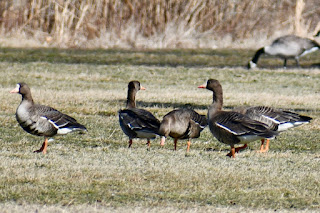Greater White-fronted Goose X 24 - 2/17/2005
I have noticed this winter to be a decent year for common mergansers and geese other than the widely distributed Canada goose species. Common mergansers and other-than-Canada geese are not local breeders and are uncommon or, depending on the species, rare around Ocean County. There are very few spots in the county to find common mergansers when they are around. Many times, some of the sightings for common mergansers are incorrect identifications of the much more probable, red-breasted mergansers. Sightings of the former are up this season. They have been reported in several locations with as many as 135 at one location. I saw mine for this year in January while checking a popular waterfowl hotspot at a local retail shopping mall. While I was scanning the variety of duck species on the water, five common mergansers dropped on the water in front of me. They were a nice change to see from all the red-breasted ones, and they saved me a trip to the outskirts of the county to find them.
Common mergansers. Left, female. Right, male. 1/29/25. © S. Weiss
Red-breasted mergansers, 2/6/23. © S. Weiss
Comparing the red-breasted mergansers here to the common mergansers above, the differences are not too hard to notice. Besides being larger, the common merganser male’s body is much whiter, lacking the grayish flanks and reddish-brown breast of the red-breasted. The common has a thicker bill and lacks the steep forehead of the red-breasted. The latter has a shaggy crest, whereas the common’s head is smooth. The female common has a clear demarcation between the brown head/neck and chest. The female common has a white chin patch that the red-breasted lacks. Habitat is also a big clue in separating the two: commons prefer fresh water, red-breasted prefers salt water.
Interesting geese (species other than Canada goose) have been showing up in New Jersey this winter, as well as other parts of the Northeast. Snow, cackling, Ross’s and pink-footed geese have popped up in New Jersey. Barnacle and bean geese have shown up elsewhere in the Northeast, particularly a taiga bean goose in New York State and a tundra bean goose in Rhode Island. But most notable are the sightings of greater white-fronted (GWF) geese. There are several subspecies of GWF geese that breed in the arctic and their nonbreeding range is the western half of the United States. There are populations in Greenland and Russia that may occasionally wander to North America. Regardless of the subspecies or population, GWF geese are rare for New Jersey. Their influx started back in December.
I stumbled across one this past December at a nearby neighborhood lagoon. Other birds had been reported elsewhere and this one barely stayed for two days before departing for parts unknown. This was the first one I had seen in New Jersey in about 17 years. Back on January 13, 2007, I found one at the same lagoon. I eBirded this goose 26 times up to May 9, 2007.
Greater white-fronted goose, with glossy ibises, Tom River, NJ, 4/17/2007. © S. Weiss
This bird stayed in the area for about four months, mostly between two locations barely a mile apart.
More sightings across New Jersey have continued through the first two months of this year. Last week an amazing flock of up to 19 birds had been reported foraging along the Garden State Parkway grass median in Atlantic County. This surely was probably a high count for the state. On Monday, I was checking the athletic fields at the township park down the street from my neighborhood. As usual, there were a couple hundred Canada geese foraging, resting and pooping out on the fields. I scanned the flocked as I always do, hoping to find that one different looking goose in the mass which usually I do without any luck. Alas, near the end of the scan I spotted one goose with its face tucked. Still, I was able to see that it had a brown head, unlike the other hundreds of black heads moving about the field. I was hoping that this was a pink-footed goose. But then I saw two other brown-headed geese nearby, and I knew I found several GWF geese.
I quickly, and excitedly texted a couple birding friends to let them know what I had found. I continued scanning and in three minutes came upon more. I quickly and excitedly texted my friends back simply saying, “Ten!!” I scanned again and in another minute saw even more. I quickly and excitedly texted my friends back, “20!!” One of my friends soon arrived and we both counted several times and came up with 22 GWF geese. Soon after that, another friend showed up and we counted 24 of them! We both counted a few times and came up with that same number. I believe this would have to be a state high count for the species.
Greater white-fronted geese, Toms River, NJ, 2/17/2025. © S. Weiss
These geese showed up at the same location as the GWF goose pictured above.
Graylag goose, Morton Lake, FL, 8/24/2024. © S. Weiss
Graylag goose is very similar looking to greater white-fronted goose. Wild graylag geese breed mostly in Europe and Asia. Most graylag geese in North America are domestic, any wild ones are rare. Graylag geese are larger than GWF, have a grayer head, less chest barring and lack the white front above their orange bills.
A few observers that came after I left listed counts ranging from 20 to 23. Counting birds that are moving about in a mixed flock is not easy and different tallies are not uncommon. I put down 24 on my eBird checklist. As my friend Larry often reminds me, “You only need one.”










Comments
Post a Comment